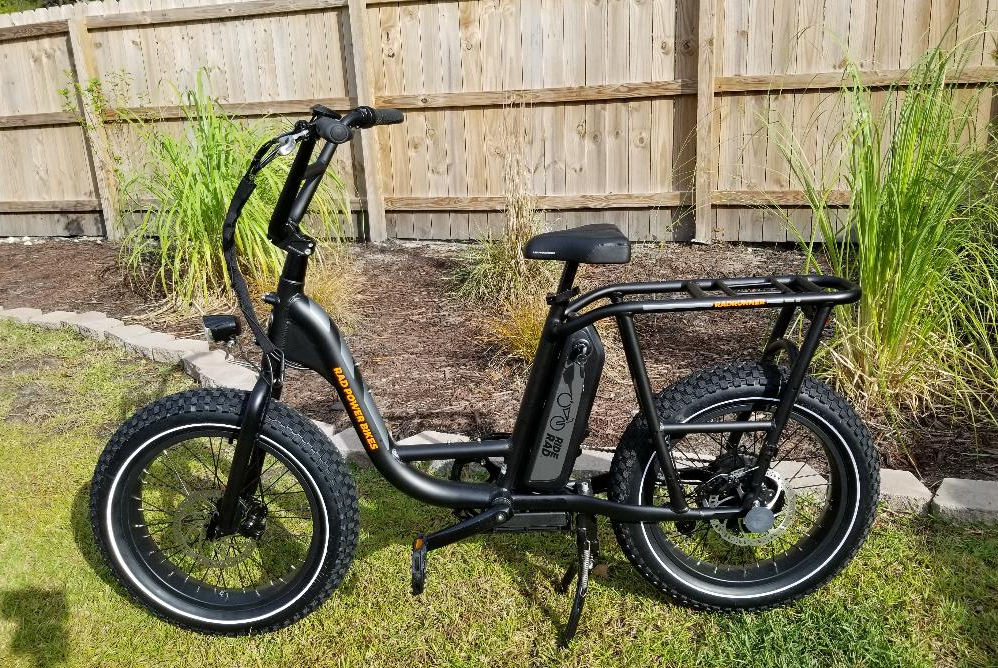- Excellent value
- Designed to be customized
- Step-thru frame easy to mount
- Great customer support
- Easy to ride
- The optional carrier console's cup and phone holders are a bit too small
- Ride can be a bit rough
Rad Power Bikes‘ moped-style RadRunner exemplifies the company’s vision for electric bikes. When Rad designed the RadRunner, every decision, including features to build in and those to leave out, was based on two principles. Value, and utility.
The RadRunner’s basics are, well, pretty basic. It’s a single geared Class 2 e-bike with four pedal-assist levels and a motorcycle-style half-twist throttle. The e-bike’s top speed with power assistance is 20 miles per hour, limited by the RadRunner’s 750-watt controller because of U.S. restrictions.

The RadRunner’s battery is good for 25 to 45 miles or more travel range, depending on passenger and cargo weight, speed, road surface, incline, weather, and more. The removable battery weighs 7.7 pounds, and can be charged on or off the bike.
Stepping down to the next level of granularity, the RadRunner has a 750-watt Bafang geared hub motor on the rear wheel hub. The motor puts out 80 Newton-meters (the equivalent of 59 pound-feet of torque). Like all e-bikes, the torque is available immediately as soon as you start pedaling or twist the throttle. The bike’s charger can fully charge the battery from empty in five to six hours.
What features made the cut?
The RadRunner has Tektro mechanical disc brakes front and rear, an adjustable moped-style seat, and adjustable aluminum 10-inch rise handlebars. The aluminum-framed e-bike has an integrated rear rack, a dual-leg kickstand, and fat 20-inch by 3.3-inch tires. The semi-knobby pneumatic tires are Kenda K-Rads, built exclusively for Rad Power Bikes with a K-Shield puncture-resistant liner and high-visibility reflective striping on both sides.
Both the RadRunner’s LED headlight and the integrated rear taillight with brake light and flash mode connect directly to the main battery, so you don’ t have to worry about replacing batteries individually. There’s an intuitive LED display by the left hand-grip that shows battery charge level, pedal assist level, and whether the lights are turned on.
What’s missing and why?
From the outset, Rad intended that the RadRunner would fill the role of the brand’s entry-level ebike, which meant the price needed to be less than the already low $1,499 the company charges for its other models. The RadRunner’s $1,299 regular price includes free shipping, although right now, the price is $1,199 while supplies last during an end-of-year sale. That’s resulted in some compromises.
Because the RadRunner’s shape and size are not in the conventional bicycle or mountain bike style, Rad opted for a single-speed derailleur. The RadRunner is surprisingly easy to pedal, but there’s just one speed unless you use electric pedal assistance.
You’ll start to feel beat up if riding on rough roads.
The RadRunner has a rigid front fork and no rear suspension. The Kenda fat tires help soften the ride, especially if you run them a bit under their maximum air pressure. Even though the RadRunner has semi-knobby rubber. Still, you’ll start to feel beat up if riding on rough roads.
The LED display doesn’t show current speed, or miles traveled, either.
So, multiple gearing speeds, suspension, and a more informative display are off the RadRunner’s spec sheet because Rad figured the target buyer wouldn’t miss them and didn’t need them for a utility e-bike if the trade-offs helped keep the cost low.
Build it your way
Rad Power Bike’s vision of utility for the RadRunner includes a high level of customization potential. By Rad’s count, there are 330 accessory combinations available from the company.
RadRunner customers can upfit the e-bike to best conform to their definition of utility with accessory selections. The accessory list includes fenders, gear racks, boxes, and bags, but the two most interesting RadRunner add-ons are the Passenger Package and Center Console. Rad has pending patents for those last two accessories, and we asked for both for our test bike.
The RadRunner Center Console takes away the easy-mounting of the step-through frame but adds a 12-liter capacity water-resistant storage compartment handy for picking up the mail or a few groceries. You could also use it to carry a notebook computer, a helmet, a few books, and an extra sweater or jacket.
The removable console top stays in place with three stretchable rubber cords. The console top has a cup holder and a smartphone compartment with an elastic strap. Most half-liter water bottles will fit in the cup holder, but the coffee cup in the photo below didn’t slide all the way down. The iPhone X in a case shown below fit the holder perfectly, but my Note 8 was just a bit too wide.
The Center Console is a $99 option. Installation is a matter of removing and reinstalling four screw bolts from the RadRunner’s frame, a process that shouldn’t take more than a couple of minutes unless, ahem, you drop the bolts.
Installing the RadRunner Passenger Package, another $99 accessory, takes a bit more time to install than the Center Console. A helpful video breaks down the passenger kit installation step-by-step.
The package includes a comfortable passenger seat that fits on top of the rear, a pair of retractable footpegs, and clear protective wheel skirts. It took less than 30 minutes to install the three components, including the time to read the documentation and watch the video.
The passenger seat is roughly 18-inches long x 7-inches wide x 3.5-inches high. The retractable footpegs mount high enough on the frame so a passenger can reach them easily and not have to hang their legs. The wheel skirts prevent passengers’ shoes or shoelaces from getting caught in the wheel spokes.

The RadRunner’s standard adjustable saddle conforms to the front of the passenger seat. You might otherwise position the saddle higher for pedaling comfort, but with the passenger seat you can slide back for a much more comfortable ride — as long as you leave enough room when you carry a passenger.
The passenger package was a total win, while I’d give the center console slight ding for its just-barely-too-small cup and phone holders.
Riding the RadRunner
The RadRunner isn’t a high-performance e-bike, but it’s easy and fun to ride. The pedal assist levels and throttle won’t power the e-bike faster than 20 mph, but without a speed display, you don’t know how fast you’re going until the electric assistance cuts out.
When the assistance stops, it stops abruptly but then cuts right back in if your speed drops. You could theoretically pedal fast enough to exceed 20 mph, but this e-bike’s single-speed gearing doesn’t encourage it.
The RadRunner may be the perfect e-bike for new riders looking for a versatile micromobility solution with a low entry cost
I rode the RadRunner primarily on pavement and sidewalks. When I rode on grass or over driveway entrance curbs at first, the ride felt overly harsh. After I dropped the tire pressure about five pounds, however, the ride was comfortable, but I still wouldn’t want to ride it off-road on any regular basis.
I didn’t notice a change in the RadRunner’s responsiveness or power while the passenger was on the back, although I also rode more carefully and didn’t lean as much going around corners.
Our Take
The RadRunner is a surprising electric bike. It makes compromises to reach its low price point, yet it has unique customization features that aren’t available on most electric bikes at any price.
This unique combination of customization and affordable pricing is what puts the RadRunner into the upper echelon of electric bikes. It’s a great way to get around town.
Is there a better alternative?
Nothing currently on the market at the RadRunner’s price level beats its value, and versatility, or its availability. Moped-style e-bikes have become a thing, however, and there are two pair of moped-style e-bikes from two other companies on the way. The first pair is Juiced Bikes‘ Scorpion and more powerful HyperScorpion e-bikes, currently on pre-order status with shipments scheduled to begin in April.
Both Juiced models are Class 3 e-bikes with 28 mph and 35 mph top speeds, respectively. The Scorpion lists for $2,199 (currently on sale for $1,399 for pre-orders) and the Hyperscorpion costs $3,499, ($2.099 for pre-orders).
Monday Motorbikes also has two Moped-style e-bike models soon to appear in an Indiegogo crowdfunding campaign, with delivery also planned for April 2020. The Monday Motorbike Gateway and Gateway Booster e-bikes are Class 2-rated models with $2,399 and $3,499 list prices.
How long will it last?
Rad Power Bikes may not use high-end components, but they make solid bikes built on 6061 aluminum frames with brand name components. The RadRunner’s single-speed gearing and lack of suspension mean there are fewer parts to fail. Maintenance will also be easier without those components. Rad Power Bikes come with a one-year limited warranty, but there’s no reason not to expect the RadRunner to last for years. The only maintenance will likely be for the disc brakes, the chain, and tires and tubes.
Should you buy one?
Yes. If you want a fun, easy-to-ride electric bike you can customize to your needs, the RadRunner is an excellent choice.


.gif)




